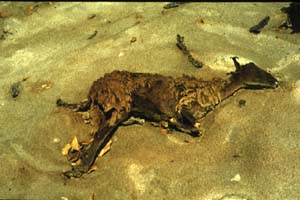
The anthrax season near Del Rio started a little early this year, with a case confirmed March 31 in a five-year-old male goat. The Texas Animal Health Commission (TAHC) is advising owners in the area to vaccinate livestock to prevent additional death losses.
“Usually we see cases of anthrax occurring in summer when the temperatures rise, but this spring has been quite warm. Anthrax occurs worldwide, but in Texas, cases are typically found in a triangle bounded by Uvalde, Ozona and Eagle Pass, which takes in portions of Crockett, Val Verde, Sutton, Edwards, Kinney, Uvalde and Maverick counties,” said Dr. Hillman, Texas’ state veterinarian and head of the Texas Animal Health Commission, the state’s regulatory agency for livestock and poultry health.
Dr. Hillman explained that anthrax bacteria lies dormant in the ground, and germination is triggered by appropriate moisture and warmth. As the bacteria migrates to the surface, it contaminates grass and soil, where it is picked up by grazing animals. Because anthrax bacteria generall does not migrate in the ground, contamination in a large pasture may be limited to
only a small area.
“Ranchers in the vicinity of anthrax cases routinely vaccinate each spring, or initiate vaccination for their cattle, sheep, goats, horses or other grazing animals as soon as a season’s first case is reported,” he said. “The injected vaccine is very effective, but there is no approved method for administering vaccine to free-ranging deer that can’t be rounded
up and restrained in a chute.”
“We don’t want anthrax-infected animals to die in transit or on a new premise and then have carcasses mishandled,” said Dr. Hillman. “Therefore, TAHC regulations require that animals on an infected premises be quarantined for at least 10 days after all the livestock have been vaccinated against the disease. During this time, anthrax-exposed animals will die from the disease without contaminating new areas, while healthy, vaccinated animals will develop immunity.”
“We also are concerned about proper disposal of anthrax-infected carcasses,” Dr. Hillman noted. Prior to release of a TAHC quarantine, carcasses of infected animals, animal bedding, and nearby manure must be burned thoroughly, to prevent anthrax bacteria from leaching into the soil, where it can remain dormant for decades. This also prevents wild pigs, coyotes, dogs or other predators from dragging carcasses (and the accompanying anthrax bacteria) from one pasture to another.
“When burning potentially infected carcasses, or vaccinating livestock against anthrax, ranchers should wear long sleeves and gloves to avoid contaminating sores on arms or hands,” cautioned Dr. Hillman. “Anthrax infection of the skin can cause a nasty sore that requires appropriate antibiotic treatment, so practice good general sanitation procedures. Wash
your hands and clothes after burning carcasses or vaccinating animals.
Consider disinfecting equipment used to move bedding, potentially infected manure or fuel. Keep pets away from carcasses, and avoid picking up bones, horns or antlers from dead animals. Healthy animals should be moved from anthrax-contaminated areas during an outbreak.”
All anthrax cases–suspected or laboratory confirmed–must be reported to the TAHC. The regulatory agency operates a 24-hour hotline at 1-800-550-8242, with state or federal regulatory veterinarians available at all times to take calls and work with private veterinary practitioners and producers.
“Hunters often ask us about anthrax and risks associated with harvesting animals,” commented Dr. Hillman. “Fortunately, by the time hunting season starts, cool weather usually puts an end to a season’s outbreak. Always harvest only healthy-looking animals. If a deer has ingested anthrax bacteria, within hours, it will stagger, tremble or exhibit convulsions,
and death is inevitable.”
“Anthrax is not a danger to travellers or vacationers in an area where cases have occurred,” stressed Dr. Hillman. “We advise tourists to avoid touching carcasses or collecting bones or antlers, and they won’t have to worry about the bacteria. Anthrax has been with us for hundreds of years, and while cases are noteworthy because of the death loss in our wildlife
and livestock, and because of the need to vaccinate, they are not alarming.”